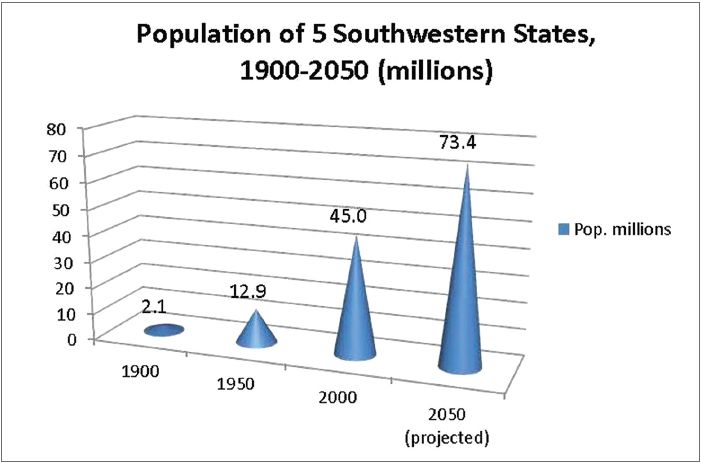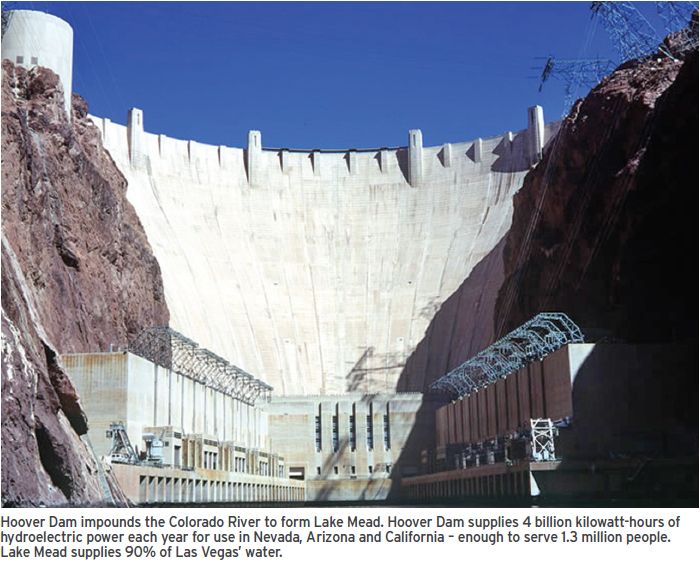EXPLODING SOUTHWEST POPULATION ON COLLISION COURSE WITH WATER SCARCITY
Published on August 13th, 2013
PDF Download: kolankiewicz_population_on_collision_course.pdf
By Leon Kolankiewicz, CAPS Senior Writing Fellow

In his classic 1986 book, Cadillac Desert, the late author Marc Reisner argued that explosive population growth and development in the American Southwest were on an inevitable collision course with the fundamental hydrological realities of an implacably arid region.
Subtitled The American West and its Disappearing Water, Cadillac Desert presented the history of two powerful federal bureaucracies in the West: the Bureau of Reclamation and the Army Corps of Engineers. Both agencies are loved and loathed in equal measure. Reisner’s book chronicles their grand scheme to tame and harness wild water resources in the West—all in the service of relentless human ambition, first to settle this once nearly empty land and then to build upon it an ever greater and enduring empire.
In the magnificent and timeless phenomenon we call the hydrologic cycle, life-giving water courses through natural ecosystems and human economies like blood through a living organism. Cadillac Desert recounts dramatically how patterns of natural water flow in the Southwest were fundamentally reengineered to serve human aims. Defying nature, water was compelled to flow uphill and during dry seasons when normally it was absent.
The topics covered in Cadillac Desert are a veritable Who’s Who of iconic Western personalities, places, achievements, aphorisms and acrimonies—John Wesley Powell, William Mulholland, Floyd Dominy, “rain follows the plow,” “whiskey is for drinking and water is for fighting,” Colorado River, Owens Valley, California water wars, Hoover Dam, Central Arizona Project, Los Angeles Department of Water and Power, etc.
For the past century, as shown in the chart, California, Nevada, Utah, Arizona and New Mexico have experienced some of the fastest, most unsustainable population growth in the entire country. The Census Bureau and state demographic agencies all project continued substantial growth as far as the eye can see.
Whether one laments or celebrates this unbridled growth, none of it would have been possible without massive water projects—dams, reservoirs, aqueducts and the like—to capture, impound and move this most precious of resources from where nature put it to where the people need it. Where the people need it is not necessarily where the people live—vast quantities of water are used to irrigate crops removed from towns and cities. (But then these crops, 70—90% water by weight, are indeed transported to the cities to feed their burgeoning populations.)
Now, a tenacious, withering drought is bringing the issues raised in Cadillac Desert to a head. The Colorado River is the crux of this crucial, colossal and complex system of water works. It furnishes the daily needs of some 40 million people in seven states—California, Arizona, Colorado, Nevada, Utah, New Mexico and Wyoming. It supplies water to the parched cities of Los Angeles, San Diego, Denver, Las Vegas and Phoenix, as well as to farmers and ranchers who use it to irrigate four million acres of cropland, upon which some 15% of the nation’s food supply is grown.
 And the Colorado River is in dire straits. If the drought continues, 2013 will be the fourth-driest year in the Colorado River basin in the past century. 2012 was the fifth-driest year on record. By the end of the year, unless the drought breaks, the river’s two largest reservoirs—Lake Powell (impounded by the Glen Canyon Dam upstream of the Grand Canyon) and Lake Mead (impounded by Hoover Dam) near Las Vegas—will only be at 45% capacity, the lowest they have been in 45 years.
And the Colorado River is in dire straits. If the drought continues, 2013 will be the fourth-driest year in the Colorado River basin in the past century. 2012 was the fifth-driest year on record. By the end of the year, unless the drought breaks, the river’s two largest reservoirs—Lake Powell (impounded by the Glen Canyon Dam upstream of the Grand Canyon) and Lake Mead (impounded by Hoover Dam) near Las Vegas—will only be at 45% capacity, the lowest they have been in 45 years.
The future doesn’t look any brighter. This past December, the federal government issued a three-year study warning that drought, climate change and population growth are rapidly surpassing the ability of the Colorado River to supply water. It reported a “troubling trajectory” of increasing water demand colliding with decreasing water supply.
Of these three factors underlying the crisis, only population growth is within our ability to modify directly. But do you think this was even on the table when 40-odd water agency officials, environmentalists, farmers and Indian tribal leaders met recently in San Diego to consider how to address the crisis? Most certainly not. Instead they discussed “techno-fixes” like water sales from agricultural to municipal interests and concocting new and innovative approaches for squeezing still more water from one of the most overexploited rivers on Earth.
Yet another techno-fix proposed to do an end run around water scarcity is desalination. Given that California enjoys an 840-mile coastline with the Pacific Ocean—a hypothetically unlimited supply of water—this proven technology is tempting, at least superficially.
A $1 billion reverse osmosis desalination plant is currently under construction at Carlsbad. When complete, it will be the largest plant in the western hemisphere producing fresh water from the ocean’s virtually limitless bounty of salt water. Reverse osmosis is an energy-intensive process that separates freshwater (pure H2O) from both salt molecules (NaCl) and other impurities by forcing the salt water through microscopic sieves inside cylindrical filters.
According to the New York Times, at least 48,000 acre-feet of water would be sold from the new Carlsbad plant annually to the San Diego County Water Authority at about $2,000 an acre-foot, or double what the authority pays for other water. (An acre-foot is an acre covered with a foot of water, equivalent to 326,000 gallons, or what two average households consume in a year.) The Water Authority will be paying more than $3 billion over 30 years for only about 7% of its needs.
More than a dozen other desalination plants are proposed for the California Coast—at Camp Pendleton, Huntington Beach and near the Monterey/Carmel area. How polluting or sustainable the sources of energy needed to power these plants will be is a big unknown. The Carlsbad plant—which alone would consume 240 million kilowatt-hours of electricity a year—is opposed by the Surfrider Foundation and other environmental groups. The other proposed plants up the coast will surely be opposed as well.
If techno-fixes like desalination temporarily succeed in overcoming limits to population growth imposed by water scarcity—albeit at a high economic and environmental cost—allowing still more of California to be paved over for the foreseeable future, would this be a blessing? Or would it be a blessing in disguise if they did not? The quality of life and of the environment and landscape in a state of 50 million, 60 million or more inhabitants is not a pleasant thing to contemplate.
Desalination exemplifies what philosopher Craig Dilworth, in his tome Too Smart for Our Own Good: The Ecological Predicament of Humankind (Cambridge University Press, 2009), calls the vicious circle principle. Dilworth writes: “Humankind’s development consists in an accelerating movement from situations of scarcity, to technological innovation, to increased resource availability, to increased consumption, to population growth, to resource depletion, to scarcity once again, and so on.” Every time humanity goes round the circle, population swells and environmental stresses mount further. Ultimately, in Dilworth’s view, it does not end well.
In the opening pages of Cadillac Desert, author Marc Reisner chose to include the haunting sonnet “Ozymandias,” published in 1818 by Percy Bysshe Shelley (1792—1822). It tells of a “traveler from an antique land,” deep in the desert, encountering the half-buried remains of a fallen statue that peered arrogantly across a once-great empire. In light of our current predicament, the last five lines give particular pause:
“My name is Ozymandias, king of kings:
Look on my works, ye Mighty, and despair!”
Nothing beside remains. Round the decay
Of that colossal wreck, boundless and bare
The lone and level sands stretch far away.
Leon Kolankiewicz is a CAPS Senior Writing Fellow, environmental scientist and planner.




